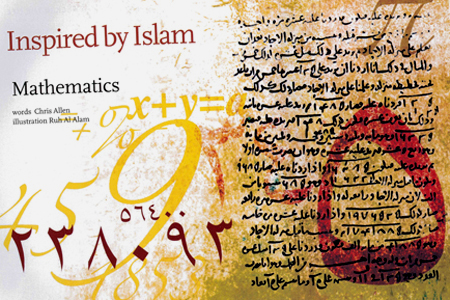
Inspired by Islam - Mathematics
Issue 3 Jan / Feb 2004
words Chris Allen
illustration Ruh Al Alam
Can you think of ways of writing a hundred without using a zero? Arabic numerals made their first appearance in 830 CE. As with all Arabic, they were written from right to left, and according to their position from the right, represented units, tend, hundreds, and so on. If a number of lacked units, tens or hundreds, was written in the appropriate place of the number, which today is the equivalent of zero.
Muslims are also credited with adopting another important mathematic tool, the decimal system. Without these developments, the entire concept of abstract mathematics would be impossible!
These systems made it possible to deal with large numbers in an efficient way, replacing previous methods that had been expressed either with full words or alphabetical letters (Roman numerals).
Muslim mathematicians were also able to extract square and cube roots and even constructed root tables. They also used the abacus for the same purpose, observing that numbers ending in 2, 3, 7, 8 or in an odd number of zeros could not be perfect squares. Without these, later European based mathematicians and scientists would not have been able to produce more complicated and extensive root tables. Nonetheless, it was these discoveries that made numbers much easier and allowed for a faster calculation.
Muslims also found themselves having to solve a number of practical and concrete problems, including the division of taxes, the calculation of tithes and the division of estates according to Qur’anic law. Similar historical texts to emerge out of this period saw Muslim texts discussing weights and measures and the methods of counting.
Muslim mathematicians also helped scientists undertake research across various branches, including physics, chemistry, and astronomy. The impact of Arabic numerals and their accompanying tools provided the basic materials needed for more advanced understanding in theses fields.
The Muslim contribution to mathematics is perhaps most famous for the development of Algebra. This was a very powerful tool and provided a means to manipulate unknown quantities in equations, itself a requirement to solving practical problems.
The works of Al-Khwarizmi (Alghorismus) were translated into Latin and from his name the mathematical term algorithm was derived. He also did much of the ground work for algebra and other complex mathematical problems, including square roots and complex fractions. He conducted numerous experiments, including measuring the height of the earth’s atmosphere and discovered the principle of the magnifying lens.
Other less complicated and more day-to-day uses of algebra could be seen in such progresses as determining the amount of grain that a granary could hold. Muslim mathematicians therefore contributed greatly to the solving of many of the daily practical problems that we sometimes take for granted.
Muslims also made a significant contribution to the field of geometry. First and foremost, they experienced with the works of the great Greek mathematician, Euclid. Initially, Muslims expressed the elements of geometric figures in terms of one another, similar to methods being used by the Greeks. However, they developed this further by establishing mean proportions and the trisection of an angle.
Although some of the most important contributions to this branch of geometry concerned the construction of regular polygons involving cubic equations and on writing on the pentagon and decagon.
The trigonometric findings of Al-Kirmani of Toledo were also translated into Latin, and it is from these that we get the sine and cosine functions along with much of what had been written about geometry elsewhere.
In the field of mathematics therefore, Muslims made a great number of advances, many of which had a significant impact on contemporary mathematics.
For more information visit:
www.thevirtualclassroom.net
www.muslimheritage.com
Bookmark this |
|
Add to DIGG |
|
Add to del.icio.us |
|
Stumble this |
|
Share on Facebook |
|
Share this |
|
Send to a Friend |
|
Link to this |
|
Printer Friendly |
|
Print in plain text |
|


Comments
0 Comments